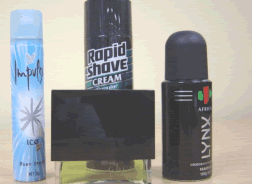Non-radioactive medicinal or toiletry articles plus Non-flammable, non-toxic aerosols in Division 2.2

 |
 |
 |
Please note the following from the table above:
| - |
Permitted in or as carry-on-baggage |
YES
|
|
| - |
Permitted in or as checked baggage |
YES
|
|
| - |
The approval of the operator(s) is required |
NO
|
|
| - |
The pilot-in-command must be informed of the location |
NO
|
Non-radioactive medicinal or toilet articles (including aerosols)
These articles include such things as perfumes, deodorants and aerosols such as hair sprays for personal use. A general airline industry way to verify whether a substance can fall into this area is:
If you can rub or spray the contents on your body, digest the medicinal article safely, then it may be termed a medicinal or toiletry article.
This would also include magnetic belts/pillows/blankets used for medicinal purposes.
A protective cap must always be attached to the individual aerosol container to prevent inadvertent release of the contents.
Non-flammable, non-toxic aerosols in Division 2.2, with no subsidiary risk, for sporting or home use.
There are many aerosols that are in Division 2.2. (Non-flammable, Non-Toxic Gas) that can be purchased for home or sporting purposes. A protective cap must always be attached to the individual aerosol container to prevent inadvertent release of the contents.
It is important to note the following information from Section 2.3.5.1 of the current IATA DGR for items falling into these categories:
- The total net quantity of all the above mentioned articles in these IATA DGR Table 2.3.A extracts must not exceed 2 kg or 2 L.
- Each individual container must not exceed 0.5 L or 0.5 kg.
- A protective cap must always be placed on bottles or aerosol containers to prevent inadvertant release of contents (or some other suitable preventative measure taken)
Also note: For international flights, security regulations can futher reduce "Carry on Baggage" in regard to liquids to 100 ml in clear plastic containers. The specifics to these security limitations will be covered in other training conducted by your Operator.

